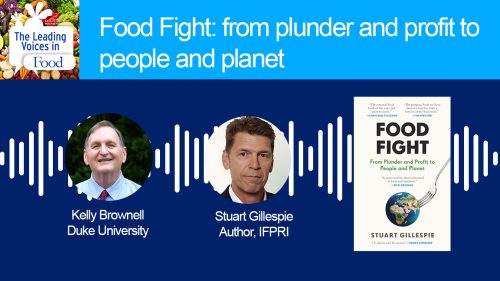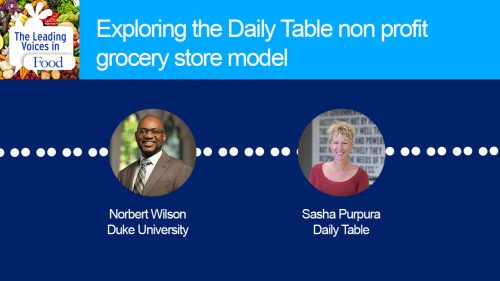The Leading Voices in Food
E132: Connecting Food with our Environment in Daily Life
Most people think about the connection between food and their budget, or food and their health, but more and more people are concerned about the connection between food and the environment. Someone who cares about this a great deal is food campaigner, Jennifer Molidor, from the Center for Biological Diversity.
Subscribe: Apple Podcasts | TuneIN | YouTube Music | SoundCloud | PocketCasts | Radio Public
Tags: Climate Change, Environment & Food | Equity, Race & Food Justice | Food Waste & Implications |

Jennifer Molidor is a senior food campaigner at the Center for Biological Diversity where she works on sustainable food and agriculture campaigns, including public and corporate policy, and individual diet shifts. Her research and analyses focus largely on meat and dairy production, food waste, and other agricultural issues. The campaigns she designs work with cities and climate action plans, school food, restaurants, grocery stores, farms, food access, government programs and wildlife conservation.
Interview Summary
So your title, Senior Food Campaigner, with the Center for Biological Diversity is a really interesting one. I’ve never heard that title.
What I do is look at food sustainability campaigns and conservation, and how these two concerns overlap. It’s a growing concern for environmental organizations to look at how food systems impact waterways, natural resources, and wildlife, especially. So one of my jobs is to kind of help people understand the connection between how our food systems impact wildlife.
Let’s talk about grocery stores and food waste. So what have you learned in your research about American food markets and food waste, and what do you think are some important strategies?
So I’ve been working on grocery store research for a number of years now. In the United States, supermarkets are sort of the gateway to the North American food system. They’re the primary place that Americans purchase food. So from farm to fork, supermarkets have this tremendous influence on what makes it to the shelves, and then what is wasted. And we know about 40% of food that’s produced in the United States goes uneaten. And it has about a $200 billion economic impact, and it’s growing. The problem with food waste has tripled in the last 50 years. It’s wasting the water that is consumed. It’s wasting the carbon emissions, and the acreage of land use that goes into producing food. It goes into the landfills, which is a powerful source of methane and worsens the climate change crisis. And it also impacts the natural resources that native wildlife and endangered species need to survive as well. So this is one of the reasons that food waste is a key issue for people who are environmentally-minded to keep in mind. And it requires to think about policy changes, systemic changes, personal changes and so on.
And what do you think are some of the strategies that could be taken to address this issue?
Well, one of the reasons we looked at supermarkets is it’s such an enormous role to play in the supply chain in terms of what we do in our households, whether it’s a buy one, get one free deal, and so on that is encouraging waste. There’s a shopper education information that goes on and it’s just this really central place for food waste and food loss. And what I found, the first report that I wrote called, Checked Out, was that nine out of 10 American grocery stores are not even tracking and reporting the total volume of food waste. And that’s a big problem because how can you know how much food you’re wasting or if you’re improving if you’re not tracking and reporting it. And there’s no accountability. So that was really surprising. A lot of these grocers wanted to do better. I gave a benchmark of the ways that they could do better. And one way was to commit to zero waste. I think that on a timeframe, 2025 to 2030, this is possible to do, and some of the leading stores are doing it. They also need to focus on some strategies that they’re not focusing on when they kind of shift all their attention to donation instead of preventing food waste to begin with.
So you said there are particular grocers that you think are doing well with this?
Surprisingly, Walmart, when it comes to food waste, is doing some of the key strategies it needs to do to get there. Other stores like Kroger, and I’ll hold them, Hays are doing really well. So they got the top grades in our report because they’re committed to zero food waste. They’re also committed to focusing on prevention strategies rather than donation strategies. And then some of the other companies that were really trying to make efforts towards better policies were Whole Foods and Target and so on, but they’re not quite there yet. They need to commit to zero food waste, for example. And then some of the other stores didn’t engage and they’re an enormous source of waste. And there’s just a big missed opportunity here, I think for companies to not really systemically commit to zero waste because it goes all the way back up the supply chain, but it also saves them money.
Well, it’s heartening to know that some of the big players like Walmart are involved in this. Let’s turn our attention to school food. So why is school food an important environmental issue? And what are some of the obstacles and solutions?
School foods are really important for a number of reasons. Seven billion school meals are served every year and 30 million children are relying on this system, and there could be more if we had a universal school meal program. So environmentally, it has a big impact in terms of food waste, as I mentioned. A lot of dairy is wasted, as well as the types of foods that are served to our children and often to the most marginalized children. And it’s also obviously a hunger issue. A lot of these children rely on these meals as their only source of nutrition per day. And so for both of those reasons it really behooves us to take a strong look at what we’re serving and how we’re serving and how we got it and what the cost is of that food. And I mean, environmentally and I mean, in terms of justice. Are these children having an increased access to healthy sustainable brands, and is this significantly massive program also serving a healthy, sustainable diet, and for the most part, I don’t think it will be a surprise, but the answer is, no. There was a recent report in California that found that 96% of school meals were meat-based and that’s my state. And that is the state that produces a third of the nation’s vegetables and two-thirds of the countries, fruits and nuts. And it’s not getting into our schools and there’s good opportunities there with farm to school programs and so on to where we can solve a justice issue and a health issue with an environmental issue. And so schools are really this great locus for interconnections to come together and groups who are advocating for these different things. They’re totally interrelated. And so this is one area which I’m very passionate about for those reasons. And also because I’m a mother.
So I’d like to talk about your interest in food justice. Why is food justice an important key in the sustainable food movement? And how did COVID-19 highlight injustice and environmental impacts in the food system?
Yeah, it really begins with our vision. What does a sustainable food system mean? What does this sustainability mean? What is a just food system? And as we’re rethinking food policy to have a more just sustainable food system, we need to produce food that is healthy for humans. It’s healthy for the human communities who are near food production systems. It’s healthy for the food workers who help produce our food. And it also means be healthy for wildlife and natural resources and our climate and so on. Injustice in the food system comes with dire environmental impacts, right? So if we’re going to fight climate change, we’re going to mitigate the impacts of our food system. We have to do it for everybody. We have to increase access to a healthy sustainable food system across the board. And so it’s a systemic problem that comes with a systemic solution. Those individual choices matter too, but looking broadly at the sustainability of our food system and how it was revealed during COVID in ways we didn’t want to talk about, a number of problems made themselves clear.
One of them is the connection between what I would call exploitation of environmental resources with wildlife, with farmed animals, with human workers with marginalized human workers and so on, was really just made evident. It was always there, but it was really made evident during COVID in terms of the meat packing industry and how the four main companies who own the majority of meat in the United States or produce the majority of meat really had significant influence on the previous administration and administration before that, in terms of invoking the Defense Production Act, right, to make meat and not masks. And so what we saw was a lot of marginalized vulnerable people in the workplace that had no protective equipment, no social distancing spaces, no healthcare, no breaks for bathroom or meals and so on. And these are the workers who are least likely to have a sustainable wage. And they’re working in the most dangerous industry in the United States, and meanwhile, they’re also most likely to be impacted by toxins and dangers in the workplace. They’re also least likely to have access to healthy, sustainable food. And so this is kind of like a microcosm look at the dangers and the negative impacts of our food system on vulnerable communities that is also having a disastrous impact on our planet.
So let me ask you one final question. I’ve heard you referred to how changing the way we eat could help address an extinction crisis. Could you explain?
We have to competing crises. Climate change and then we also have biodiversity loss. And the biodiversity crisis or the extinction crisis around the world is as impactful as the climate crisis. It also impacts marginalized communities as does climate change, first and foremost, and it’s going to impact our ability to grow food. For example, in California, we’re having decline in Monarch butterflies, for example, and other pollinators. If we don’t have pollinators, we largely can’t grow food. We are now talking about food security issues. The ways that ecosystems work around the world threatened an endangered species, the loss of them is going to impact the waterways, the natural environments the places that we grow food and so on.
And then we saw that with the pandemic as well that the more we encroach on habitat, the more we’re sort of clear cutting forests and grasslands and in making room for meat production, for example, the habitat loss, water loss, water use, food waste, all of these wasteful parts of our food system are really severely impacting species around the world that are wild. We are in an ecosystem. So what happens to one part of the planet is going to impact the rest of us as well. And it’s happening here in the United States, as well, as I said, with the butterflies and the pollinators and bees and so forth. We have to think about ourselves in terms of how we are interrelated with nature because it’s going to impact the natural world as well as human health.









